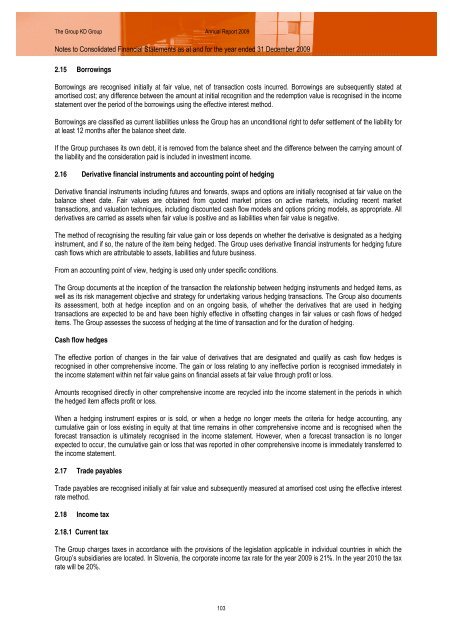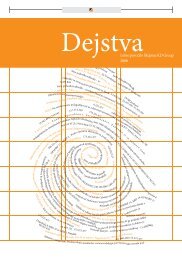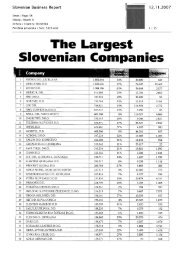The Group KD Group and KD Group dd
The Group KD Group and KD Group dd
The Group KD Group and KD Group dd
You also want an ePaper? Increase the reach of your titles
YUMPU automatically turns print PDFs into web optimized ePapers that Google loves.
<strong>The</strong> <strong>Group</strong> <strong>KD</strong> <strong>Group</strong> Annual Report 2009<br />
Notes to Consolidated Financial Statements as at <strong>and</strong> for the year ended 31 December 2009<br />
2.15 Borrowings<br />
Borrowings are recognised initially at fair value, net of transaction costs incurred. Borrowings are subsequently stated at<br />
amortised cost; any difference between the amount at initial recognition <strong>and</strong> the redemption value is recognised in the income<br />
statement over the period of the borrowings using the effective interest method.<br />
Borrowings are classified as current liabilities unless the <strong>Group</strong> has an unconditional right to defer settlement of the liability for<br />
at least 12 months after the balance sheet date.<br />
If the <strong>Group</strong> purchases its own debt, it is removed from the balance sheet <strong>and</strong> the difference between the carrying amount of<br />
the liability <strong>and</strong> the consideration paid is included in investment income.<br />
2.16 Derivative financial instruments <strong>and</strong> accounting point of hedging<br />
Derivative financial instruments including futures <strong>and</strong> forwards, swaps <strong>and</strong> options are initially recognised at fair value on the<br />
balance sheet date. Fair values are obtained from quoted market prices on active markets, including recent market<br />
transactions, <strong>and</strong> valuation techniques, including discounted cash flow models <strong>and</strong> options pricing models, as appropriate. All<br />
derivatives are carried as assets when fair value is positive <strong>and</strong> as liabilities when fair value is negative.<br />
<strong>The</strong> method of recognising the resulting fair value gain or loss depends on whether the derivative is designated as a hedging<br />
instrument, <strong>and</strong> if so, the nature of the item being hedged. <strong>The</strong> <strong>Group</strong> uses derivative financial instruments for hedging future<br />
cash flows which are attributable to assets, liabilities <strong>and</strong> future business.<br />
From an accounting point of view, hedging is used only under specific conditions.<br />
<strong>The</strong> <strong>Group</strong> documents at the inception of the transaction the relationship between hedging instruments <strong>and</strong> hedged items, as<br />
well as its risk management objective <strong>and</strong> strategy for undertaking various hedging transactions. <strong>The</strong> <strong>Group</strong> also documents<br />
its assessment, both at hedge inception <strong>and</strong> on an ongoing basis, of whether the derivatives that are used in hedging<br />
transactions are expected to be <strong>and</strong> have been highly effective in offsetting changes in fair values or cash flows of hedged<br />
items. <strong>The</strong> <strong>Group</strong> assesses the success of hedging at the time of transaction <strong>and</strong> for the duration of hedging.<br />
Cash flow hedges<br />
<strong>The</strong> effective portion of changes in the fair value of derivatives that are designated <strong>and</strong> qualify as cash flow hedges is<br />
recognised in other comprehensive income. <strong>The</strong> gain or loss relating to any ineffective portion is recognised immediately in<br />
the income statement within net fair value gains on financial assets at fair value through profit or loss.<br />
Amounts recognised directly in other comprehensive income are recycled into the income statement in the periods in which<br />
the hedged item affects profit or loss.<br />
When a hedging instrument expires or is sold, or when a hedge no longer meets the criteria for hedge accounting, any<br />
cumulative gain or loss existing in equity at that time remains in other comprehensive income <strong>and</strong> is recognised when the<br />
forecast transaction is ultimately recognised in the income statement. However, when a forecast transaction is no longer<br />
expected to occur, the cumulative gain or loss that was reported in other comprehensive income is immediately transferred to<br />
the income statement.<br />
2.17 Trade payables<br />
Trade payables are recognised initially at fair value <strong>and</strong> subsequently measured at amortised cost using the effective interest<br />
rate method.<br />
2.18 Income tax<br />
2.18.1 Current tax<br />
<strong>The</strong> <strong>Group</strong> charges taxes in accordance with the provisions of the legislation applicable in individual countries in which the<br />
<strong>Group</strong>’s subsidiaries are located. In Slovenia, the corporate income tax rate for the year 2009 is 21%. In the year 2010 the tax<br />
rate will be 20%.<br />
103







